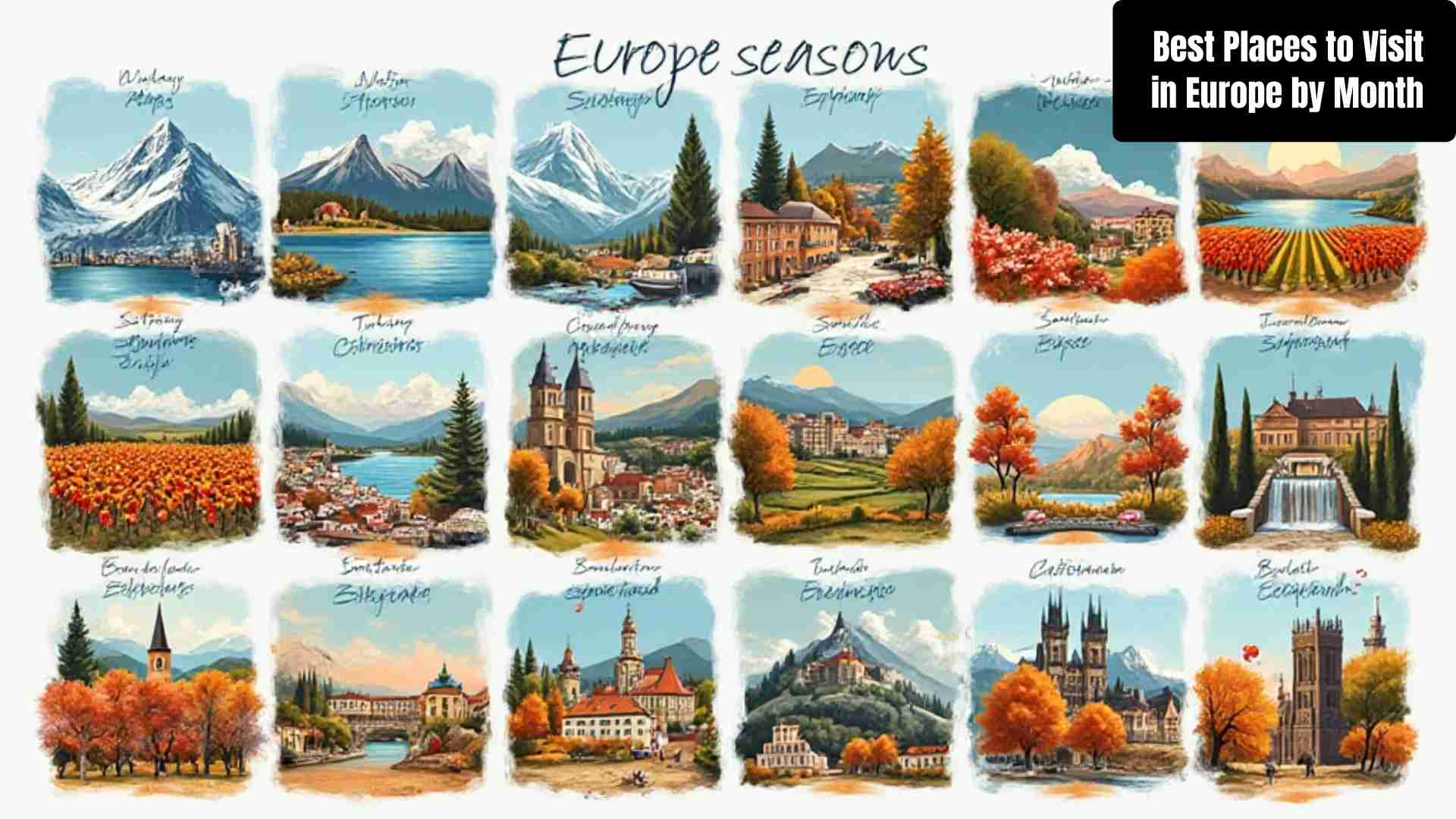Planning a trip to Europe can feel exciting, but also overwhelming. With so many countries, climates, and cultures packed into one continent, it’s easy to wonder: When is the best time to go, and where should I head each month? The truth is, Europe has something beautiful to offer year-round. Whether you love snowy adventures, spring blossoms, summer festivals, or autumn colors, you’ll always find a destination that fits your mood.
This guide breaks down the best places to visit in Europe by month, so you can plan your travels without second-guessing. Instead of giving you just a list, I’ll share what makes each month special, what you can expect weather-wise, and a few things to keep in mind before booking.
January – Embrace Winter Magic
If you don’t mind the cold, January is a wonderful time to see Europe in its winter coat. The festive buzz from Christmas still lingers, and ski resorts are in full swing. Crowds are lighter in cities, which means cheaper flights and hotel deals.
- Austria (Innsbruck, Salzburg, Vienna): Perfect for skiing in the Alps or exploring snow-dusted baroque streets. The mountains around Innsbruck feel like stepping into a postcard.
- Switzerland (Zermatt, St. Moritz): A paradise for winter sports lovers, though it can be pricey. Still, nothing beats the sight of the Matterhorn covered in snow.
- Norway (Tromsø): This is one of the best months to chase the Northern Lights. Long nights give you a higher chance of seeing them dance across the sky.
Things to keep in mind: Days are short, especially in northern Europe, so plan activities earlier in the day. If you’re not a fan of the cold, southern Spain or Portugal are milder options.
February – Romance and Festivities
February is all about cozy escapes and vibrant carnivals. With Valentine’s Day in the middle of the month, it’s a popular time for couples’ getaways.
- Paris, France: The city of love lives up to its name in February. Imagine quiet walks along the Seine with fewer tourists around.
- Venice, Italy: The famous Carnival of Venice fills the streets with masks, costumes, and parades. It’s crowded but magical.
- Tenerife, Canary Islands (Spain): If you prefer sunshine over scarves, Tenerife offers warm weather and one of Europe’s biggest carnivals.
Things to keep in mind: Weather can still be cold and damp in central and northern Europe, so pack layers. Also, flights around Valentine’s Day can get expensive—book early if possible.
March – Spring Awakening
March is when Europe starts to wake up from winter. Flowers begin to bloom, and the days slowly stretch longer. It’s a transitional month, so you’ll find both snow in the mountains and early spring vibes in the cities.
- Dublin, Ireland: St. Patrick’s Day in March turns the whole city into one big festival. Expect music, parades, and a lively pub scene.
- Amsterdam, Netherlands: Early spring is when the tulips start peeking out, though the famous Keukenhof gardens fully open at the end of March.
- Seville, Spain: The orange trees bloom, filling the air with fragrance. The weather is pleasantly mild compared to the scorching summers.
Things to keep in mind: The weather can be unpredictable. One day sunny, the next rainy. Pack a light raincoat and don’t forget comfortable shoes for walking.
April – Blossoms and Easter Celebrations
April is when Europe truly comes alive with color. Spring flowers carpet city parks and countryside meadows, while Easter brings unique traditions across the continent.
- Amsterdam & Keukenhof, Netherlands: By mid-April, tulips are at their best. A bike ride through flower fields feels like a dream.
- Rome, Italy: Easter in the Vatican is a once-in-a-lifetime experience. Even if you’re not religious, the atmosphere is unforgettable.
- Ljubljana, Slovenia: A quieter gem where riverfront cafés buzz with locals enjoying the warmer weather.
Things to keep in mind: Easter week means higher prices and bigger crowds, especially in Rome and other religious hubs. If you’re after peace, smaller towns or offbeat destinations are better.
May – Ideal for Outdoor Adventures
May is one of the best months to visit Europe. The weather is warm but not too hot, flowers are still blooming, and tourist crowds haven’t reached their summer peak yet.
- Cinque Terre, Italy: Perfect for hiking between colorful seaside villages before the summer rush.
- Paris, France: Parks like Jardin du Luxembourg and Tuileries are full of blossoms. The city feels alive but not overcrowded.
- Budapest, Hungary: Warm enough for Danube river cruises, yet cool enough to soak in thermal baths.
Things to keep in mind: May is popular for school trips and early holidaymakers, so book trains and popular attractions in advance.
June – Summer Kicks Off
June marks the start of summer, with long sunny days and lively festivals. It’s an ideal month for travelers who want great weather without peak July–August crowds.
- Barcelona, Spain: Beaches are open, but not too crowded yet. Plus, the city hosts music festivals like Primavera Sound.
- Santorini, Greece: The island sparkles in June. Think sunsets in Oia without the shoulder-to-shoulder crowds of July.
- Reykjavik, Iceland: June means nearly 24 hours of daylight, perfect for exploring waterfalls, hot springs, and volcanic landscapes.
Things to keep in mind: Prices start creeping up as summer approaches. If you’re traveling in June, book ferries, flights, and accommodations early.
July – Festivals and Sunshine
July is peak summer in Europe, which means warm weather, lively beaches, and lots of festivals. It’s also the busiest month, so expect higher prices and bigger crowds.
- Pamplona, Spain: Famous for the Running of the Bulls during the San Fermín festival. Not for the faint-hearted, but the atmosphere is electric.
- Edinburgh, Scotland: Long days and mild weather make it perfect for exploring castles, hiking Arthur’s Seat, or enjoying whisky tours.
- French Riviera (Nice, Cannes, Monaco): Ideal for a glamorous beach holiday. The Mediterranean sparkles under the July sun.
Things to keep in mind: July heat can be intense in southern Europe—temperatures in places like Rome or Athens often exceed 35°C. Stay hydrated and consider sightseeing early in the morning.
August – Mediterranean Vibes
August is when many Europeans take their holidays, so beaches and tourist spots can get packed. Still, it’s an amazing month for coastal getaways.
- Dubrovnik, Croatia: Crystal-clear waters and historic old town walls make it a dream destination. Yes, it’s crowded, but undeniably stunning.
- Mykonos, Greece: Famous for its nightlife and beaches, August is when the island is at its liveliest.
- Berlin, Germany: The city buzzes with open-air concerts, beer gardens, and cultural festivals. A great mix of history and modern energy.
Things to keep in mind: Accommodation prices skyrocket in August, especially in southern Europe. If you prefer quieter escapes, head north to Scandinavia or the Baltics.
September – Golden Autumn Begins
September is a sweet spot for travel. The weather is still warm, but crowds start thinning out as summer holidays end. Vineyards glow with harvest colors, and cities feel more relaxed.
- Tuscany, Italy: September is wine harvest season. Rolling hills, golden vineyards, and food festivals make it one of Europe’s most romantic months.
- Munich, Germany: Late September marks the start of Oktoberfest, the world’s most famous beer festival.
- Lisbon, Portugal: Pleasantly warm without the scorching August heat. The city’s hills and pastel-colored streets feel more relaxed this time of year.
Things to keep in mind: While southern Europe still feels summery, northern regions like Scandinavia begin cooling quickly. Pack accordingly.
October – Autumn Colors and Cultural Escapes
October is a month of golden leaves, cozy cafés, and fewer tourists. It’s also harvest season, which means wine, fresh produce, and food festivals across Europe.
- Prague, Czech Republic: The city’s Gothic charm shines under autumn leaves. Cooler weather makes castle walks and river cruises more enjoyable.
- Bavaria, Germany: Beyond Oktoberfest, October is perfect for scenic drives through the Alps with fiery autumn landscapes.
- Transylvania, Romania: Halloween in Dracula’s homeland adds a spooky twist to an already atmospheric region.
Things to keep in mind: Days get shorter, and rain becomes more common. It’s a great month for culture and scenery rather than beach holidays.
November – Quiet and Cozy
November is often overlooked, but it has its perks: fewer crowds, lower prices, and a cozy vibe before the Christmas season begins.
- London, UK: Christmas lights go up in late November, and museums are warm havens on chilly days.
- Budapest, Hungary: Thermal baths feel especially inviting as the air cools down.
- Athens, Greece: Still milder than much of Europe, with ancient sites far less crowded than in summer.
Things to keep in mind: Weather can be gloomy, especially in northern Europe. If you’re chasing sunshine, southern Spain and the Canary Islands are better bets.
December – Festive Wonderland
December transforms Europe into a magical Christmas storybook. From markets to snowy escapes, it’s one of the most enchanting months to visit.
- Vienna, Austria: Famous for its Christmas markets filled with lights, music, and mulled wine.
- Cologne, Germany: Home to some of Europe’s best holiday markets, set against the backdrop of its stunning cathedral.
- Lapland, Finland: For the ultimate Christmas experience—reindeer rides, Santa Claus Village, and Northern Lights.
Things to keep in mind: Book early, as December is busy with holiday travelers. In northern Europe, expect very short days but plenty of festive charm.
Final Thoughts
One of the joys of traveling in Europe is that there’s no single “perfect” time to go. Instead, every month offers something different. Whether you’re dreaming of skiing in Switzerland in January, tulip fields in April, beach hopping in Greece in June, or Christmas markets in December, there’s always a destination that matches your mood.
The key is to travel with the season, not against it. Embrace the snow if you go in winter, enjoy the blossoms in spring, celebrate the festivals of summer, and soak in the colors of autumn. When you align your trip with what each month naturally offers, Europe feels even more magical.
Top 5 Countries to Visit in Europe: A Traveler’s Guide



1 thought on “Best Places to Visit in Europe by Month”